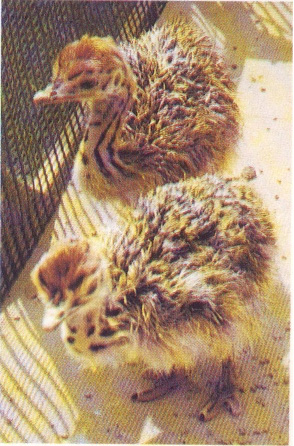TODAY'S FARM ANIMALS
THE INSIDE STORY
Page i
OSTRICHES
'On one occasion l saw and sketched a female tending her hatchlings. The young will get careful attention from both male and female adults before they develop the necessary independence to be on the move with the family group.,
John Seerey-Lester.
 For their first three months of life ostrich chicks are very delicate Photo: FAWN |
Ostriches can grow to be nine feet tall and live for up to eighty years, breeding into their forties. Thriving in hot, dry climates they roam over vast distances and can run at speeds of up to 40 mph.
The Farmed Ostrich
A rash of ostrich breeding centres is spreading over the UK, with parent stock, chicks and fertile eggs being imported and exported, changing hands at inflated prices.
These impressive birds are now confined in small paddocks, the chicks often herded into sheds to protect them from the British climate. Ostriches have no preen gland, so their feathers are not 'waterproofed' and easily become sodden. In the absence of the seeds and grasses of the South African veld, they're fed on broiler-type pellets.
Ostriches are Classed as 'Dangerous Wild Animals' and Must Be Licensed* Eggs are removed daily to be artificially incubated. Males become highly aggressive at this time and farmers take elaborate precautions to protect themselves from attack;
'....A kick from one of those powerful legs with its huge claw can cause horrible injury, and fatal attacks have been recorded.' Dr Brian Bertram, Director of Slimbridge Wildfowl Trust
Ostrich Chicks For their first three months of life ostrich chicks are very delicate, often dying for no apparent reason (the 'fading chick syndrome'). In their natural habitat ostrich chicks are strong and hardy.
* At the time of writing - Spring 1998
Diseases of Intestification
Infectious diseases and leg problems are emerging, and stress is a major killer too. Self-inflicted injuries occur when the easily frightened ostriches run into fencing, or damage each other, accidentally or through aggression. Much of their suffering is associated with their life in captivity and the deprivation of parental care.
Catching, Transport and Slaughter
It's all too easy to imagine the stresses and injuries that will occur when these huge and highly-strung birds are rounded up for slaughter. To render the ostrich blind and helpless, a 'hood' (often an old sock) may be forced over his or her head, and, like a condemned criminal, this magnificent bird is led to slaughter. All this, to supply a 'novelty' meat and expensive leather and feathers for the fashion trade!
The Breeding Stock
As with all commercially-reared poultry today, the breeding stock lead unnatural and stressful lives. In the wild, ostriches select their mates carefully, the males indulging in exotic and prolonged dances to attract the chosen female. Both sexes are dedicated parents for nearly a year, after which time the chicks can fend for themselves. Life on a British farm will rob ostriches of the opportunity to fulfil almost all of their basic instincts.
Fears for the Future
There are indications from all over the world that ostriches are being forced down the same road as broiler chickens and turkeys, in a ruthless quest for quick weight gain and profits. Already farmed ostriches are suffering many of the health and welfare problems endured by billions of intensively reared poultry.
'Other efficiency gains could be made by doubling the amount of meat each bird produces. Dr Coleman (president of a US poultry consulting firm - Ed.) believes that the red and blue neck ostriches which on average weigh 500 to 550 pounds each, can be bred to grow up to 1000 pounds.'
World Poultry, Misset, Vol 10, No 8, '94
The Hatchlings by John Seerey-Lester will be available in a limited edition print released by NWF Editions, UK distributor:
Birmingham B 1 1 LE